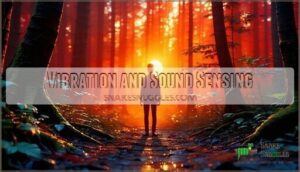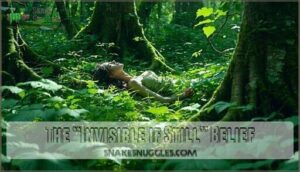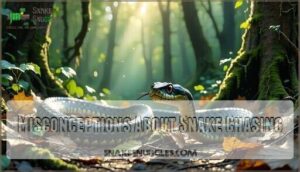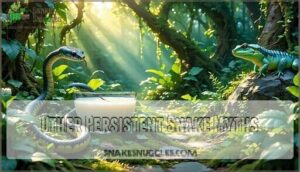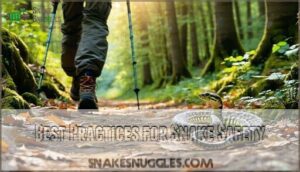This site is supported by our readers. We may earn a commission, at no cost to you, if you purchase through links.
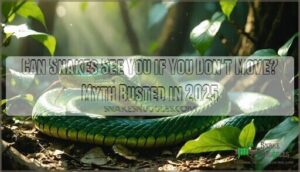
Your body heat, chemical scent, and even subtle vibrations from breathing give you away. Diurnal snakes have decent color vision and can spot you regardless of movement, while species with heat pits detect your warm body like thermal imaging.
**Different snake species vary dramatically in their sensory capabilities and hunting strategies.
Table Of Contents
- Key Takeaways
- Can Snakes See You if You Don’t Move?
- How Snakes Sense Their Environment
- Common Myths About Snake Senses
- Factors Affecting Snake Encounters
- Best Practices for Snake Safety
- Frequently Asked Questions (FAQs)
- Can a snake see me?
- Can snakes see at night to true or false?
- Does a snake see humans?
- Do snakes sleep with their eyes open True and false?
- How do snakes detect their environment without eyes?
- What are the sensory capabilities of snake tongues?
- Do snakes have seasonal changes in behavior?
- How do different snake species vary in vision?
- Can snake vision improve their hunting strategies?
- Do all snake species have the same vision abilities?
- Conclusion
Key Takeaways
- You can’t become invisible to snakes by staying still – While remaining motionless reduces detection by 70% for some species, snakes use heat-sensing pits, chemical detection through their forked tongues, and vibration sensing to locate you regardless of movement.
- Different snake species have vastly different detection abilities – Diurnal snakes rely more on vision and movement detection, while nocturnal species like pit vipers use infrared heat sensors that work like thermal cameras, making your body temperature a dead giveaway.
- Snakes use multiple senses simultaneously, not just vision – Their forked tongues collect chemical cues from your scent, specialized organs detect ground vibrations from breathing or heartbeat, and heat pits sense temperature differences as small as 0.005°F.
- The "freeze and you’re safe" advice is dangerously incomplete – While staying still can help with some species, you need proper protective clothing, calm movement techniques, and respect for snake habitats rather than relying solely on motionlessness for safety.
Can Snakes See You if You Don’t Move?
You’ve probably heard the old advice to freeze like a statue when you spot a snake, but this popular belief oversimplifies how these fascinating reptiles actually hunt and detect threats.
While staying still can reduce your chances of being noticed by some snake species, the reality is far more complex than this simple rule suggests.
Snake Vision and Motion Detection
Snake vision varies dramatically among species, but most rely heavily on motion sensitivity rather than sharp visual acuity. While diurnal snakes possess decent color vision, nocturnal species have retinal adaptations optimized for light detection over detail.
Many snake myths claim you’re invisible when still, but snake vision actually detects movement exceptionally well. Combined with infrared detection in some species, snake senses extend far beyond what snake facts usually reveal.
Scientific Studies on Stillness and Detection
Research shows that remaining motionless substantially reduces your chances of being spotted by snakes, but it’s not foolproof. Multiple studies confirm that while immobility advantages exist, snakes use multi-modal sensing beyond vision alone.
Key findings from snake behavior research:
- Motion detection studies: Vipers missed 70% more stationary prey compared to moving targets
- Olfactory systems: Snakes detect chemical trails from still animals using forked tongues
- Vibration detection: Ground tremors from breathing or heartbeat can reveal your location
- Camouflage importance: Stillness works best when combined with visual concealment
- Species variation: Heat-sensing snakes can spot warm, motionless potential predator threats
Snakes also possess infrared detection abilities that aid in hunting.
Differences Among Snake Species
Not all snake species see you the same way when you freeze up. Different hunting styles mean your stillness strategy varies in effectiveness across species.
| Snake Type | Vision Characteristics |
|---|---|
| Diurnal Species | Sharp daytime vision, detect movement and shapes |
| Nocturnal Species | Rod-dominated eyes, rely more on heat/scent |
| Arboreal Snakes | Enhanced depth perception for tree traversal |
Diurnal vs. nocturnal hunting techniques create distinct snake behavior patterns. Heat pit sensors in pythons and vipers detect your body temperature regardless of movement. Scale morphology and venom variations don’t directly affect vision, but arboreal adaptations often include better eyesight for traversing branches and spotting prey.
How Snakes Sense Their Environment
You can’t truly understand snake encounters without knowing how these extraordinary hunters experience the world around them. While your eyes might be your primary sense, snakes rely on an impressive toolkit of specialized abilities that make staying perfectly still just one piece of a much larger puzzle.
Role of Forked Tongue and Jacobson’s Organ
That forked tongue isn’t just for show—it’s your local snake’s chemical detection system. When snakes flick their tongues, they’re collecting scent molecules and transferring them to the Jacobson’s organ in their mouth. This specialized organ function helps with prey identification and scent tracking, meaning snakes smell their surroundings even when you’re perfectly still. Snakes can determine direction using chemical gradient analysis.
- Chemical Detection: Tongue flicking collects airborne and surface molecules for analysis
- Scent Tracking: Jacobson’s organ processes chemical information to locate prey and threats
- Prey Identification: Snakes distinguish between different animals through chemical signatures
- Organ Function: This chemoreceptor system works independently of vision and movement detection
Heat Pits and Infrared Detection
Something notable happens when certain snakes hunt in darkness—they literally see heat. Pit vipers, pythons, and some boas possess specialized heat pits that detect infrared radiation from warm-blooded prey up to three feet away. These organs work like biological thermal cameras, sensing temperature differences as small as 0.005°F. This means you can’t simply freeze in place to avoid detection by these snake characteristics.
Heat pit evolution gave these snakes a game-changing advantage for nocturnal hunting, completely debunking common misconceptions about remaining motionless for safety. Pit vipers rely on specialized pit organs to sense their prey.
| Snake Type | Heat Detection Range | Hunting Style |
|---|---|---|
| Pit Vipers | 0.5-1 meter | Ambush predator |
| Pythons | 0.3-0.8 meter | Constrictor |
| Boas | 0.2-0.6 meter | Nocturnal hunting |
| Non-pit Snakes | No heat detection | Visual/chemical |
Vibration and Sound Sensing
While snakes can’t detect high-pitched sounds like you’d hear, they’re far from deaf. Their inner ears pick up ground vibrations and low frequency airborne sounds through jawbone detection. This vibration range spans 50-1,000 Hertz, giving them ground sensitivity that reveals your footsteps even when you’re perfectly still.
These auditory limitations don’t mean they’re helpless—snakes have ears perfectly tuned for survival.
Common Myths About Snake Senses
You’ve probably heard that snakes can’t see you if you don’t move, but this popular belief oversimplifies how these exceptional predators actually hunt and navigate their world.
While staying still might help you avoid detection by some snake species, these reptiles rely on multiple complex senses that work together to locate prey and potential threats.
The “Invisible if Still” Belief
You’ve probably heard someone say that snakes can’t see you if you don’t move. This myth persists despite scientific evidence showing otherwise. While stillness does reduce visual detection, it doesn’t guarantee invisibility.
Here’s what science reveals about this common misconception:
- Detection thresholds vary – Some snakes miss stationary prey, but many still sense you through heat, scent, or vibrations
- Species variation matters – Pit vipers detect warm bodies regardless of movement, while others rely more on motion
- Sensory interplay is key – Snakes use multiple senses simultaneously, not just vision
- Evolutionary advantage exists – Motion detection helps snakes survive, but they haven’t lost other abilities
- Myths about snakes often oversimplify complex sensory systems that work together
Misconceptions About Snake Chasing
Unfortunately, many people believe snakes will chase people, but this common misconception stems from misunderstanding snake behavior. Snakes don’t exhibit chasing aggression toward humans—they’re naturally shy creatures that prefer retreat behavior when threatened.
What looks like snake pursuit is usually a panicked animal seeking the nearest escape route, which might accidentally be in your direction. Cornering dangers increase when snakes feel trapped and can’t flee.
Other Persistent Snake Myths
Beyond chasing myths, several other snake misconceptions persist widely. The "milk myth" claims bowls of milk attract snakes, but reptiles can’t digest dairy. People wrongly believe cutting off a snake’s head keeps it alive until sundown, that mother snakes swallow their young when threatened, and that snakes always travel in pairs. Blue-tongue lizards don’t help gardens by deterring snakes—snakes actually eat them. This is due to the fact that snakes are lactose intolerant reptiles.
Factors Affecting Snake Encounters
Understanding what draws snakes to certain areas and times helps you avoid unwanted encounters. Your behavior choices, from how you move to what you wear, can substantially impact whether a snake detects your presence.
Habitat and Time of Day
Your chances of encountering snakes depend heavily on where you are and when you’re there. Different habitats host varying snake species, while timing affects their activity patterns substantially.
Understanding these factors helps you stay safer outdoors:
- Nocturnal vs. Diurnal: Most snakes are crepuscular (dawn/dusk active), though some species shift to nocturnal behavior during hot summers.
- Seasonal Activity: Spring and late summer see peak snake movement due to mating and pre-winter feeding.
- Habitat Variation: Shrubland and farmland edges show highest human-snake conflict rates compared to urban areas.
- Arboreal Snakes: Tree-dwelling species may be less visible but still present in wooded habitats.
Heat pits help venomous species like rattlesnakes detect prey regardless of lighting conditions. Most snake bites occur when people accidentally disturb snakes in their preferred microhabitats. Burrowing habits mean ground-dwelling species dominate near human dwellings, making up 90% of encounters in residential areas.
Camouflage and Scent
Your natural body odor and visual appearance create a detection challenge when snakes can pick up chemical cues from stationary sources. While camouflage effectiveness helps against visual hunters, olfactory detection remains your biggest concern since snakes use their forked tongues constantly. To further mitigate detection, consider snake scent masking.
| Factor | Visual Detection | Scent Detection |
|---|---|---|
| Natural Colors | Reduces snake vision targeting | No effect on chemical cues |
| Scent Masking | Irrelevant to sight-based hunting | Blocks prey identification signals |
| Common Misconceptions | "Snakes see only movement" | "Stillness makes you invisible" |
| Reality Check | Scales and heat pits detect more | Tongue-flicking finds stationary sources |
Movement Versus Stillness in Avoidance
Looking at this subtopic, I’ll focus specifically on "Movement Versus Stillness in Avoidance" within the context of snake encounters, incorporating the required keywords naturally.
Staying still isn’t foolproof against snakes see you scenarios because detection modalities extend beyond vision. While immobility benefits exist against motion-detecting prey species, multi-sensory input means snakes have ears that detect vibrations and use scent tracking. Common misconceptions suggest freezing guarantees invisibility, but snake locomotion brings them closer through chemical trails.
Camouflage importance increases when combined with scent masking strategies for complete avoidance success. Snakes also use tail vibrations as alarms to signal potential danger.
Best Practices for Snake Safety
Now that you understand how snakes detect their surroundings through multiple senses, you can take practical steps to stay safe in snake habitats. While staying still might help with some species, combining smart movement techniques with proper gear and calm behavior gives you the best protection.
Avoiding Sudden Movements
When encountering snakes, your Controlled Movements can mean the difference between safety and a dangerous snakebite. Quick motions trigger their hunting instincts, making you appear like prey.
Here’s how to move safely around snakes:
- Practice Motion Camouflage – blend slow movements with your surroundings
- Execute Gradual Retreat – back away inch by inch without turning around
- Use Predictable Motion – avoid jerky or erratic movements that startle snakes
- Plan Evasive Maneuvers – identify escape routes before moving
- Keep fangs in sight – maintain visual contact while retreating slowly
Consider using specialized snake gaiters for enhanced leg protection. Remember: snakes don’t want confrontation either.
Protective Clothing and Footwear
Proper gear acts as your first line of defense against snakebites. Choose boots with high ankle support and material durability—leather or thick synthetic materials work best. Snake gaiters provide extra protection, covering the gap between your boot height and pants. Avoid bright colors; neutral or camouflage patterns help you blend into natural environments.
For added protection, consider investing in specialized footwear options. Remember, venomous snakes’ fangs can penetrate thin materials, so thickness matters more than style when preventing snake venom injection.
Staying Calm and Respectful in Snake Habitats
When you encounter snakes in their natural habitat, remember that you’re the visitor. Keep your distance—at least six feet from venomous snakes—and maintain a calm demeanor to avoid startling them.
Snakes rarely see humans as prey, so they’ll usually retreat if given an escape route. Practice respectful observation and ethical photography from afar, preserving their habitat while protecting yourself from potential snakebites.
Frequently Asked Questions (FAQs)
Can a snake see me?
Yes, snakes can see you even when you’re perfectly still. Like a security camera with multiple sensors, snakes don’t rely solely on vision—they detect heat, vibrations, and chemical cues through their tongue and specialized organs, making motionlessness an incomplete hiding strategy.
Can snakes see at night to true or false?
Most snakes have limited night vision, but some species like pythons and vipers use heat-sensing pits to detect warm-blooded prey in complete darkness, making them effective nocturnal hunters.
Does a snake see humans?
Here’s the answer, but there’s more to this story than meets the eye. Yes, snakes can see humans, though their vision varies by species. Many rely heavily on heat detection, vibrations, and scent rather than sharp eyesight to locate you.
Do snakes sleep with their eyes open True and false?
True – snakes sleep with their eyes open because they lack eyelids. Instead, they’ve a clear protective scale called a spectacle covering each eye that can’t close like human eyelids do.
How do snakes detect their environment without eyes?
You’ll find snakes rely on vibrations through their jawbones, chemical detection via forked tongues, and heat-sensing pits to navigate their world effectively without depending on vision.
What are the sensory capabilities of snake tongues?
Like ancient telegram operators, you’ll discover that snake tongues work as chemical messengers. They collect airborne particles and transfer them to the Jacobson’s organ in their mouth, which processes these chemical signals like a refined smell-taste detector for hunting prey.
Do snakes have seasonal changes in behavior?
Yes, snakes experience significant seasonal behavior changes. You’ll notice they’re most active during warmer months when they hunt, mate, and move frequently. **During winter, they brumate (similar to hibernation), becoming sluggish and seeking shelter.
How do different snake species vary in vision?
Ever wonder why some snakes hunt brilliantly at night while others struggle? Diurnal species have better color vision and shape detection, while nocturnal snakes possess rod-dominated retinas optimized for light sensitivity over sharp detail.
Can snake vision improve their hunting strategies?
Snakes improve hunting success by combining limited vision with other senses. While most can’t see stationary prey clearly, they’ll spot movement.
Heat-sensing pits, chemical detection through tongues, and vibration sensing create a multi-sensory hunting advantage that’s deadly effective.
Do all snake species have the same vision abilities?
No, snake vision abilities vary substantially between species. Diurnal snakes have better color vision and detail resolution, while nocturnal species rely more on light sensitivity than sharp eyesight for hunting.
Conclusion
Remember this truth like a lighthouse cutting through fog: the question of whether can snakes see you if you dont move fact or fiction has a clear answer. Snakes absolutely can detect you even when you’re perfectly still.
Their heat-sensing abilities, chemical detection through scent, and decent eyesight work together to locate potential threats or prey. While staying motionless might reduce your chances of being noticed by some species, it’s never a guarantee of invisibility.
Respect snakes’ impressive sensory abilities and practice proper safety measures.
- https://ragingreptiles.com/blog/f/understanding-heat-pits-in-snakes-nature%E2%80%99s-thermal-superpower
- https://www.cleverir.com/tech-notes/19-how-the-pit-viper-measures-infrared-radiation
- https://journals.biologists.com/jeb/article/225/24/jeb244478/286197/Pit-viper-thermography-the-pit-organ-used-by
- https://www.amnh.org/explore/news-blogs/pit-viper-thermal-detection
- https://www.nature.com/articles/s41598-019-40466-0



